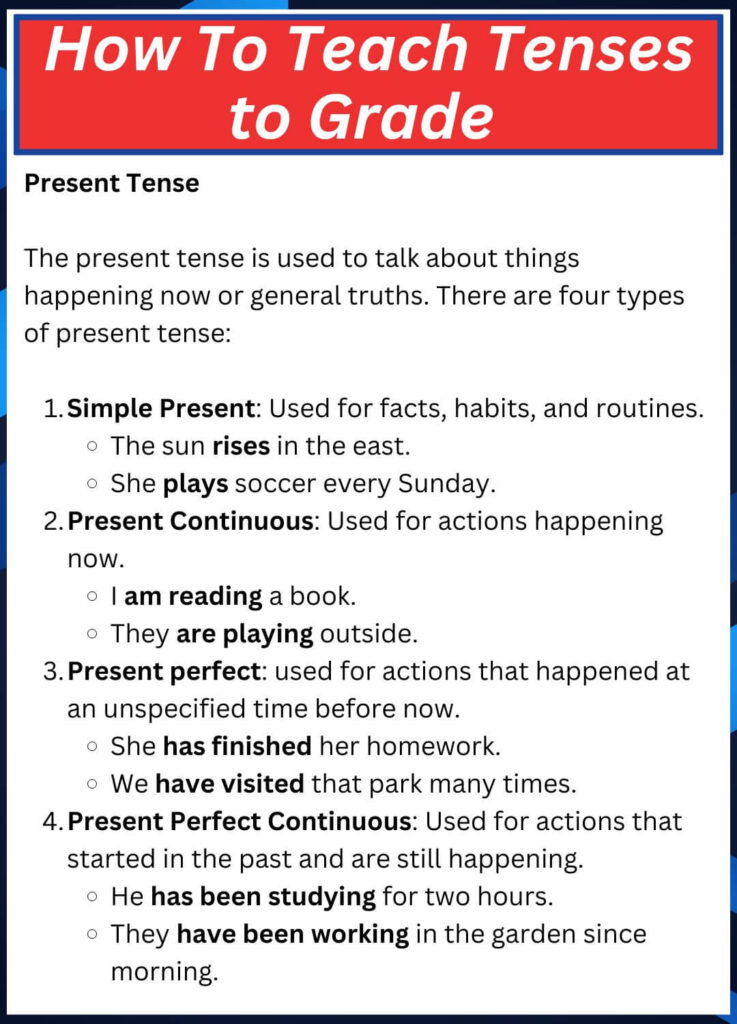Understanding tenses is an important step in learning English. If you’re looking for the best way to teach tenses to Grade 3 students, this guide will help you with simple explanations and examples. In this guide, we will explore how to teach tenses to grade 3 in the easiest way.
Present Tense
The present tense is used to talk about things happening now or general truths. There are four types of present tense:
- Simple Present: Used for facts, habits, and routines.
- The sun rises in the east.
- She plays soccer every Sunday.
- Present Continuous: Used for actions happening now.
- I am reading a book.
- They are playing outside.
- Present perfect: used for actions that happened at an unspecified time before now.
- She has finished her homework.
- We have visited that park many times.
- Present Perfect Continuous: Used for actions that started in the past and are still happening.
- He has been studying for two hours.
- They have been working in the garden since morning.
Past Tense
The past tense is used to describe actions that have already happened. There are four types:
- Simple Past: Used for completed actions.
- She went to school yesterday.
- We played football last night.
- Past continuous: Used for actions that were happening at a specific time in the past.
- I was watching TV when the phone rang.
- They were running in the park.
- Past perfect: used to show that one past action happened before another.
- She had finished her homework before dinner.
- By the time we arrived, the movie had started.
- Past Perfect Continuous: Used for actions that continued for some time in the past.
- He had been working there for five years before he left.
- We had been waiting for an hour before the bus came.
Future Tense
The future tense is used for actions that will happen later. There are four types:
- Simple Future: Used for decisions, promises, or future actions.
- She will visit her grandmother tomorrow.
- They will play football next week.
- Future Continuous: Used for ongoing actions in the future.
- I will be studying at this time tomorrow.
- She will be waiting for you.
- Future Perfect: Used to show that an action will be completed before a certain time in the future.
- By next year, she will have finished her course.
- We will have completed the project by Friday.
- Future Perfect Continuous: Used for actions that will continue up to a specific time in the future.
- By noon, they will have been working for six hours.
- She will have been teaching here for ten years next month.

FAQs on Teach Tenses to Grade 3
1. How to teach tenses to Grade 3?
Use simple sentences, fun activities, and storytelling. Start with the present tense and gradually introduce past and future tenses with examples.
2. How to teach present tense to Grade 3?
Teach them through daily activities like talking about their routine. Use simple present for habits and present continuous for actions happening now.
3. What is the easiest way to teach tenses?
Make it fun with games, songs, and real-life examples. Visual aids and storytelling also help kids understand different tenses.
4. How do you explain tenses to a child?
Use simple words and relatable examples. Show how tenses change by using the same sentence in present, past, and future forms.
5. How do you introduce tenses in a fun way?
Play grammar games, act out sentences, use flashcards, or make kids tell short stories using different tenses.
6. What is the best way to practice tenses?
The best way to practice tenses is through daily exercises, storytelling, and real-life conversations. Writing short sentences in different tenses, playing grammar games, and using worksheets can also help reinforce learning.
7. How do you introduce simple tenses?
Start with real-life examples and use simple, everyday actions to explain the concept. Show how verbs change in the past, present, and future with easy sentences like:
- Present: I eat an apple.
- Past: I ate an apple.
- Future: I will eat an apple.
Using visuals, role-playing, and interactive activities can make learning more engaging.
8. How to teach tenses to Class 4?
For Class 4 students, use a step-by-step approach:
- Start with the present tense (simple and continuous) as it relates to their daily life.
- Introduce the past tense with storytelling and picture descriptions.
- Explain the future tense using plans and predictions.
- Use fun activities like fill-in-the-blanks, sentence building, and games to reinforce learning.
- Encourage speaking and writing practice by asking students to describe their daily routines or weekend plans in different tenses.

